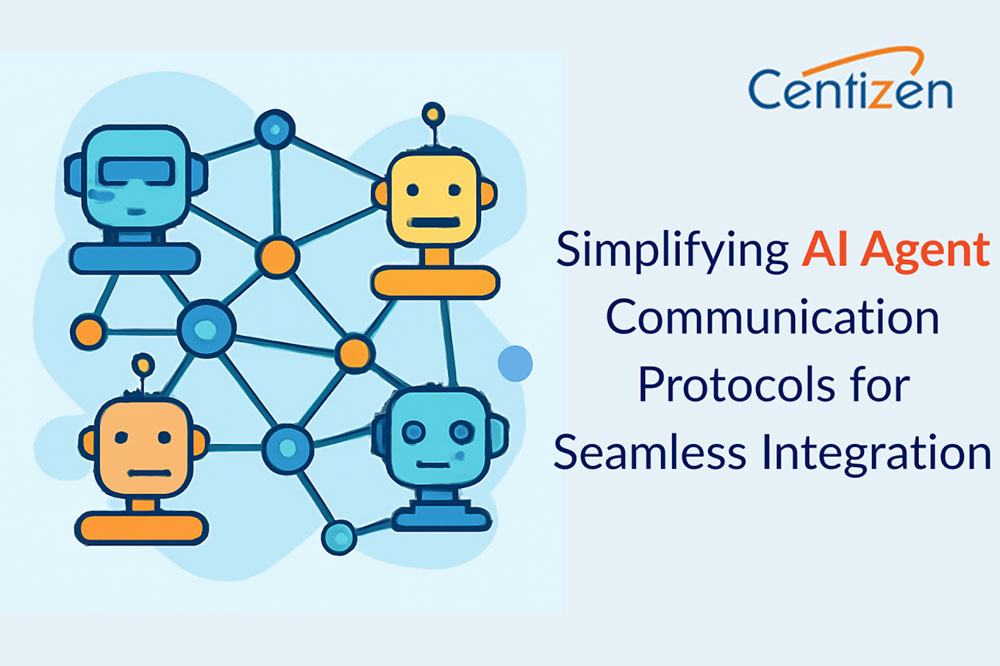Simplifying AI Agent Communication Protocols for Seamless Integration

In the fast-paced world of artificial intelligence, effective communication between AI agents is essential for delivering high-performance and collaborative systems. However, the rise of competing standards for AI agent communication is leading to fragmentation, making it difficult for organizations to realize the full potential of agentic AI. In this article, we’ll break down the key points around the issue and the solution to simplifying AI agent communication protocols.
1. The need for AI agent communication
- Core purpose: AI agents, whether they’re large language models (LLMs), IoT digital twins, or service bots, must communicate seamlessly to exchange information, collaborate on tasks, and make decisions autonomously.
- Critical for business: Effective agent-to-agent communication is crucial for enterprises looking to integrate AI into workflows for enhanced productivity, automation, and decision-making.
2. The current state: Competing protocols
- The rise of competing standards: Various players in the AI space, like OpenAI, Microsoft, Meta, and others, have developed their own communication protocols.
- Fragmentation: With so many emerging standards, agents trained on different protocols can’t seamlessly interact, creating a siloed ecosystem.
3. The negative impact of multiple standards
- Increased complexity: Enterprises must choose between multiple protocols, each with its own specifications, leading to complexity in integration.
- Cost and vendor lock-in: Organizations face higher costs due to the need for custom integrations and the risk of getting locked into a single vendor’s ecosystem.
- Wasted resources: Debating and implementing different standards is resource-intensive, often taking focus away from solving real business problems.
4. Lessons from IT history: Too many standards
- Past examples of fragmentation: The IT industry has witnessed similar patterns before—CORBA, DCOM, and WS-* standards all aimed at solving distributed computing problems, but failed due to overcomplexity and lack of adoption.
- Simpler solutions worked: REST and JSON eventually won due to their simplicity and ease of implementation. They didn’t try to be everything for everyone, making them the preferred choice for developers and businesses alike.
5. The importance of simplification
- Focus on core messaging: Most communication between AI agents can be simplified to just a few message types—request, response, notify, and error. These basic elements can handle the majority of use cases.
- Trust and context management: Trust negotiation, context passing, and complex interactions can be handled incrementally, as needs evolve.
- Avoiding over-engineering: Striving for an infinitely extensible and universal protocol often leads to over-engineering. A simpler, minimum viable protocol (MVP) can achieve the same goal.
6. The case for a minimum viable protocol
- HTTP+JSON: A simple protocol, such as HTTP with JSON, could meet the needs of 80% of AI agent communication cases.
- Common schemas: By using common schemas and allowing for optional extensions, AI agents could communicate effectively while remaining flexible for future use cases.
- Iterative approach: The MVP protocol can be enhanced over time, but starting with something simple reduces the overhead of maintaining multiple standards and increases adoption.
7. Breaking the cycle: A call for industry consensus
- Industry collaboration: AI providers should focus on creating open, interoperable standards rather than competing to push their own proprietary protocols.
- Focus on business value: Protocols should be designed with real-world business needs in mind—maximizing efficiency, reducing complexity, and driving collaboration between AI agents.
- Incremental progress: Building abstraction layers that prevent lock-in and promoting interoperability will help foster a healthy ecosystem without the need for constant protocol rewrites.
8. Conclusion: Simplifying the future of AI agent communication
- Stop complicating things: The industry must learn from the past and focus on simplicity. AI agent communication can be achieved with just a few simple protocols that promote interoperability across various systems and vendors.
- Better collaboration: By adopting a common, straightforward communication protocol, businesses can focus on leveraging AI agents to solve real challenges, without getting bogged down by competing standards.
- Long-term success: The future of AI agent collaboration lies in the ability to communicate simply, efficiently, and securely, allowing AI to truly transform business operations.
Our services:
- Staffing: Contract, contract-to-hire, direct hire, remote global hiring, SOW projects, and managed services.
- Remote hiring: Hire full-time IT professionals from our India-based talent network.
- Custom software development: Web/Mobile Development, UI/UX Design, QA & Automation, API Integration, DevOps, and Product Development.
Our products:
- ZenBasket: A customizable ecommerce platform.
- Zenyo payroll: Automated payroll processing for India.
- Zenyo workforce: Streamlined HR and productivity tools.
Services
Send Us Email
contact@centizen.com
Centizen
A Leading Staffing, Custom Software and SaaS Product Development company founded in 2003. We offer a wide range of scalable, innovative IT Staffing and Software Development Solutions.
Call Us
India: +91 63807-80156
USA & Canada: +1 (971) 420-1700
Send Us Email
contact@centizen.com
Centizen
A Leading Staffing, Custom Software and SaaS Product Development company founded in 2003. We offer a wide range of scalable, innovative IT Staffing and Software Development Solutions.
Call Us
India: +91 63807-80156
USA & Canada: +1 (971) 420-1700
Send Us Email
contact@centizen.com






